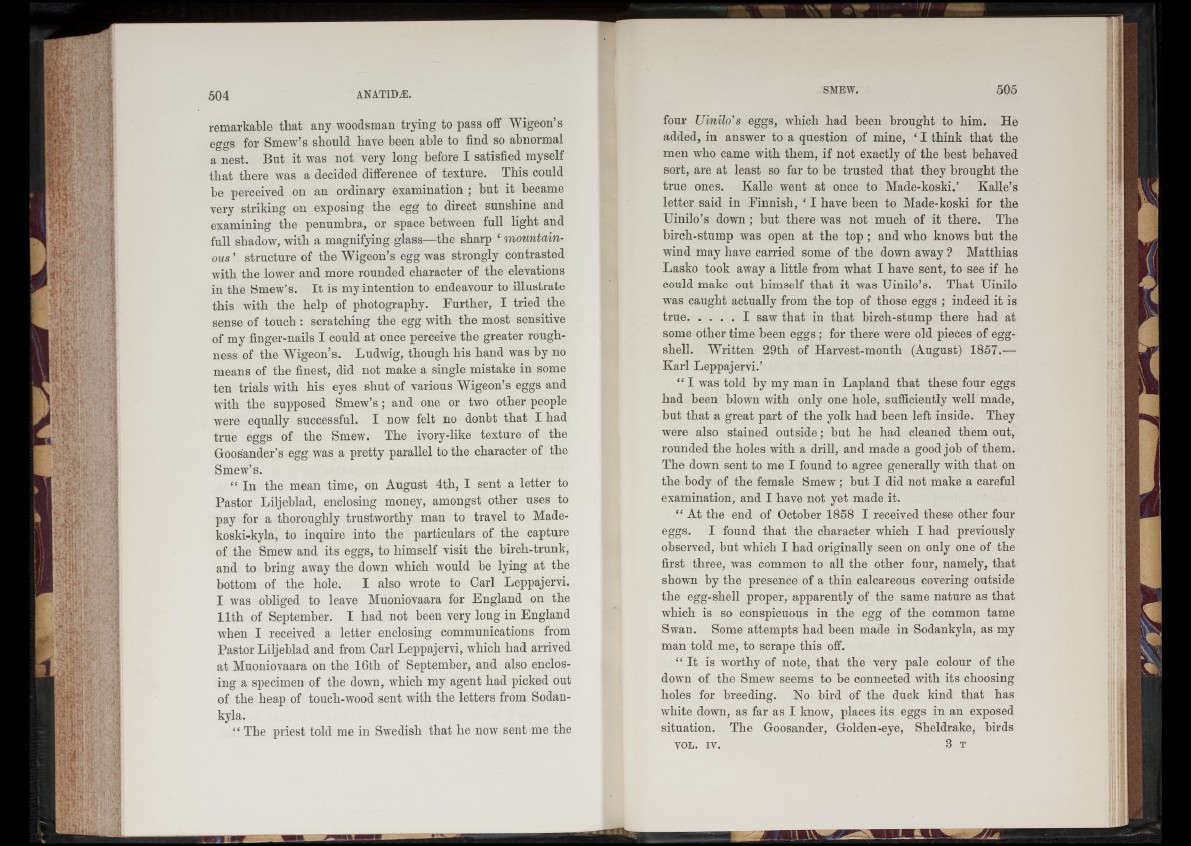
remarkable that any woodsman trying to pass off Wigeon’s
eggs for Smew’s should have been able to find so abnormal
a nest. But it was not very long before I satisfied myself
that there was a decided difference of texture. This could
be perceived on an ordinary examination ; but it became
very striking on exposing the egg to direct sunshine and
examining the penumbra, or space between full light and
full shadow, with a magnifying glass—the sharp ‘ mountainous
’ structure of the Wigeon’s egg was strongly contrasted
with the lower and more rounded character of the elevations
in the Smew’s. It is my intention to endeavour to illustrate
this with the help of photography. Further, I tried the
sense of touch : scratching the egg with the most sensitive
of my finger-nails I could at once perceive the greater roughness
of the Wigeon’s. Ludwig, though his hand was by no
means of the finest, did not make a single mistake in some
ten trials with his eyes shut of various Wigeon’s eggs and
with the supposed Smew’s ; and one or two other people
were equally successful. I now felt no doubt that I had
true eggs of the Smew. The ivory-like texture of the
Goosander’s egg was a pretty parallel to the character of the
Smew’s.
“ In the mean time, on August 4th, I sent a letter to
Pastor Liljeblad, enclosing money, amongst other uses to
pay for a thoroughly trustworthy man to travel to Made-
koski-kyla, to inquire into the particulars of the capture
of the Smew and its eggs, to himself visit the birch-trunk,
and to bring away the down which would be lying at the
bottom of the hole. I also wrote to Carl Leppajervi.
I was obliged to leave Muoniovaara for England on the
11th of September. I had not been very long in England
when I received a letter enclosing communications from
Pastor Liljeblad and from Carl Leppajervi, which had arrived
at Muoniovaara on the 16th of September, and also enclosing
a specimen of the down, which my agent had picked out
of the heap of touch-wood sent with the letters from Sodan-
kyla.
“ The priest told me in Swedish that he now sent me the
four ZJinilo's eggs, which had been brought to him. He
added, in answer to a question of mine, ‘ I think that the
men who came with them, if not exactly of the best behaved
sort, are at least so far to be trusted that they brought the
true ones. Kalle went at once to Made-koski.’ Kalle’s
letter said in Finnish, * I have been to Made-koski for the
Uinilo’s down ; but there was not much of it there. The
birch-stump was open at the top ; and who knows but the
wind may have carried some of the down away ? Matthias
Lasko took away a little from what I have sent, to see if he
could make out himself that it was Uinilo’s. That Uinilo
was caught actually from the top of those eggs ; indeed it is
true.............I saw that in that birch-stump there had at
some other time been eggs ; for there were old pieces of eggshell.
Written 29th of Harvest-month (August) 1857.—
Karl Leppajervi.’
“ I was told by my man in Lapland that these four eggs
had been blown with only one hole, sufficiently well made,
but that a great part of the yolk had been left inside. They
were also stained outside; but he had cleaned them out,
rounded the holes with a drill, and made a good job of them.
The down sent to me I found to agree generally with that on
the body of the female Smew ; but I did not make a careful
examination, and I have not yet made it.
“ At the end of October 1858 I received these other four
eggs. I found that the character which I had previously
observed, but which I had originally seen on only one of the
first three, was common to all the other four, namely, that
shown by the presence of a thin calcareous covering outside
the egg-shell proper, apparently of the same nature as that
which is so conspicuous in the egg of the common tame
Swan. Some attempts had been made in Sodankyla, as my
man told me, to scrape this off.
“ It is worthy of note, that the very pale colour of the
down of the Smew seems to be connected with its choosing
holes for breeding. No bird of the duck kind that has
white down, as far as I know, places its eggs in an exposed
situation. The Goosander, Golden-eye, Sheldrake, birds
VOL. iv . 8 T
W^JLLA.